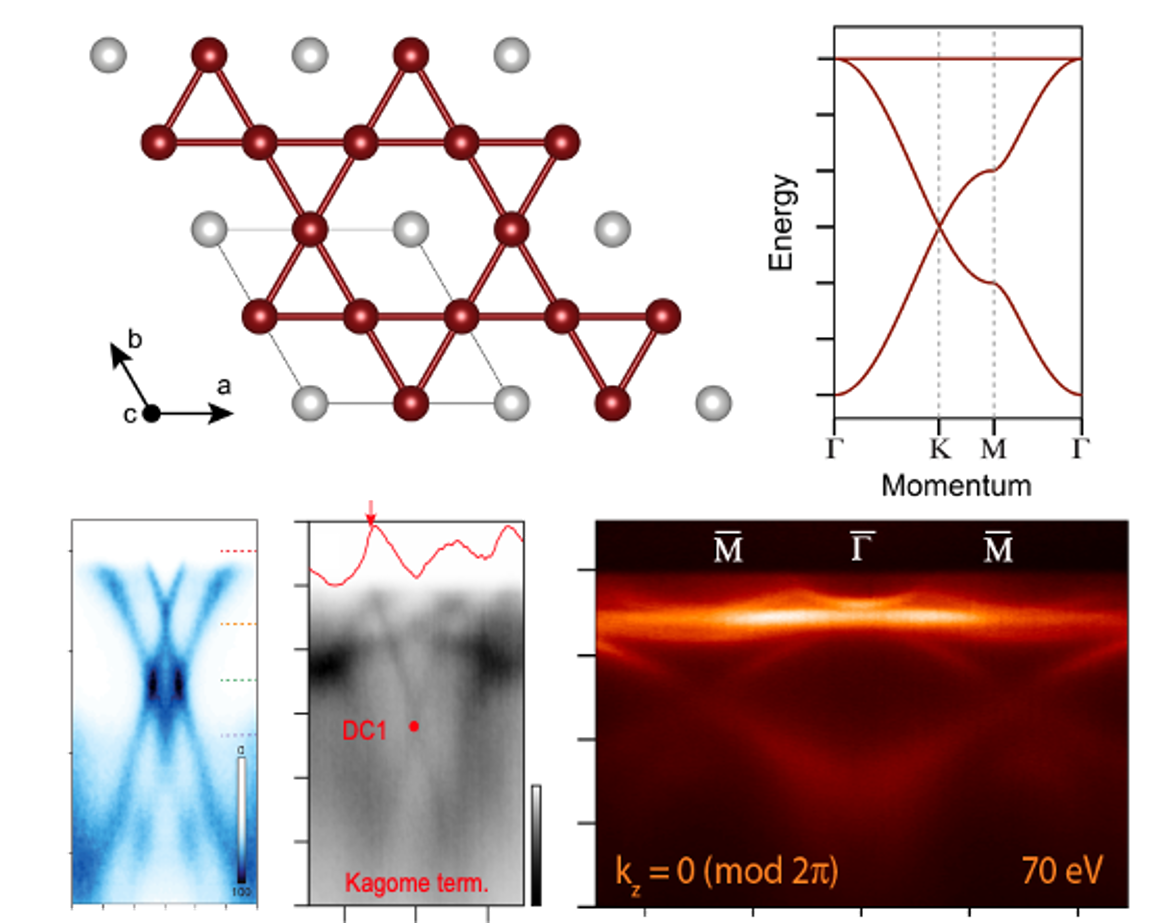 In a periodic solid, the symmetries of the atomic lattice are imprinted onto the electronic wave function, often engendering new electronic phenomena. A celebrated example is the emergence of (relativistic) Dirac electrons protected by the hexagonal symmetry of graphene. The kagome lattice is a two-dimensional network of corner-sharing triangles resembling ‘David star’ or ‘Japanese basket weaving’ patterns (top-left). The symmetry of the kagome lattice is special, in the sense that it simultaneously protects both infinitely light massless Dirac fermions and infinitely heavy dispersionless flat bands (top-right).
Despite the long-standing theoretical interest on the peculiar band structure of the 2D kagome lattice, its experimental realization in real materials has been challenging. Only very recently, a series of 3d-transition metal kagome metals has been identified as prime candidates to exhibit Dirac fermions and flat bands arising from the kagome lattice symmetry. The kagome network in these compounds is based on 3d-transition metal atoms (top-left), and depending on the chemistry (V, Mn, Fe, Co, Ni) and interlayer stacking order (AA, AB, etc), this series of compounds offers a remarkable variety of phenomena at the intersection of magnetism, spin-orbit physics, electronic topology, and dimensionality. Since 2017, our group has been studying the electronic band structure of kagome metals and its nontrivial topology. Examples of our recent findings using angle-resolved photoemission spectroscopy include massive double Dirac cones in ferromagnetic kagome metal Fe3Sn2, coexisting surface and bulk Dirac electrons in antiferromagnetic FeSn, topological flat bands in paramagnetic CoSn (collaboration with J. Checkelsky), and van Hove singularity-derived Fermi surface nesting in CsV3Sb5 (collaboration with S. Wilson).
In a periodic solid, the symmetries of the atomic lattice are imprinted onto the electronic wave function, often engendering new electronic phenomena. A celebrated example is the emergence of (relativistic) Dirac electrons protected by the hexagonal symmetry of graphene. The kagome lattice is a two-dimensional network of corner-sharing triangles resembling ‘David star’ or ‘Japanese basket weaving’ patterns (top-left). The symmetry of the kagome lattice is special, in the sense that it simultaneously protects both infinitely light massless Dirac fermions and infinitely heavy dispersionless flat bands (top-right).
Despite the long-standing theoretical interest on the peculiar band structure of the 2D kagome lattice, its experimental realization in real materials has been challenging. Only very recently, a series of 3d-transition metal kagome metals has been identified as prime candidates to exhibit Dirac fermions and flat bands arising from the kagome lattice symmetry. The kagome network in these compounds is based on 3d-transition metal atoms (top-left), and depending on the chemistry (V, Mn, Fe, Co, Ni) and interlayer stacking order (AA, AB, etc), this series of compounds offers a remarkable variety of phenomena at the intersection of magnetism, spin-orbit physics, electronic topology, and dimensionality. Since 2017, our group has been studying the electronic band structure of kagome metals and its nontrivial topology. Examples of our recent findings using angle-resolved photoemission spectroscopy include massive double Dirac cones in ferromagnetic kagome metal Fe3Sn2, coexisting surface and bulk Dirac electrons in antiferromagnetic FeSn, topological flat bands in paramagnetic CoSn (collaboration with J. Checkelsky), and van Hove singularity-derived Fermi surface nesting in CsV3Sb5 (collaboration with S. Wilson).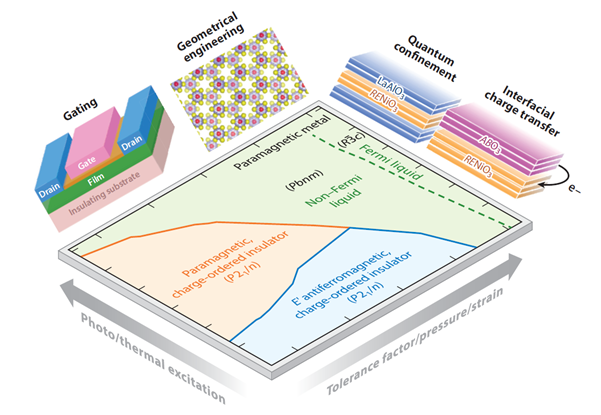 Rare earth nickelates, with chemical formula RENiO3, exhibit a rich variety of collective electron behavior including charge and spin ordering, and metal-to-insulator transitions. The ground state properties of RENiO3 are highly sensitive to different physical parameters such as lattice distortion, strain, carrier doping, and dimensional confinement. We are interested in understanding the electronic and magnetic ground state across the electronic phase diagram of these materials. Supported by collaborations with many scientists all over the world, we have studied the unique properties of these materials using X-ray spectroscopy and resonant soft X-ray scattering on nanometer-thick thin films of RENiO3. Recent topics of interests include: electronic inhomogeneity and phase separation phenomena in the spin (antiferromagnetic domain structure) and charge (metal/insulator phase coexistence) degrees of freedom; study of the electronic and magnetic properties in doped RENiO3 via oxygen vacancies and hydrogen intercalation; and characterization and manipulation of the non-collinear magnetic structure.
Rare earth nickelates, with chemical formula RENiO3, exhibit a rich variety of collective electron behavior including charge and spin ordering, and metal-to-insulator transitions. The ground state properties of RENiO3 are highly sensitive to different physical parameters such as lattice distortion, strain, carrier doping, and dimensional confinement. We are interested in understanding the electronic and magnetic ground state across the electronic phase diagram of these materials. Supported by collaborations with many scientists all over the world, we have studied the unique properties of these materials using X-ray spectroscopy and resonant soft X-ray scattering on nanometer-thick thin films of RENiO3. Recent topics of interests include: electronic inhomogeneity and phase separation phenomena in the spin (antiferromagnetic domain structure) and charge (metal/insulator phase coexistence) degrees of freedom; study of the electronic and magnetic properties in doped RENiO3 via oxygen vacancies and hydrogen intercalation; and characterization and manipulation of the non-collinear magnetic structure.
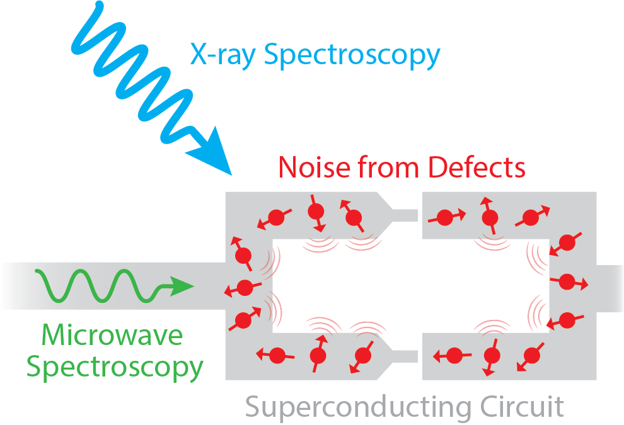 As the quantum revolution blossoms, the search for a platform to realize pristine, tunable, coupled two-level systems (quantum bits, or qubits) has become a race. This race has recently motivated rapid progress in the field of quantum control for a number of different physical systems ranging from the photonic to the solid-state. Each platform comes with benefits and disadvantages, many of which derive from how the physical qubits couple to their environment. This coupling is a double-edged sword. On one hand, it can lead to uncontrolled dissipative evolution of the system and the uninvited loss of phase information, in other words, decoherence. On the other hand, quantum systems can be utilized as sensitive probes to gain insights about the external degrees of freedom.
Superconducting circuits offer one of the most promising platforms for exploring quantum information as their large size (microns) enables fabrication with well-established lithography techniques, and the nature of the platform allows for easy control of coupling between elements. However, the mesoscopic scale of these devices is accompanied by the presence of material defects which often hinder their performance as quantum systems. In collaboration with the group of Will Oliver, we aim to explore material defects that plague superconducting circuits with a highly interdisciplinary approach. We will use the notion of quantum systems as a probe combined with the well-established physics of magnetic resonance, and complementary approaches involving X-ray absorption spectroscopy. With these tools, we hope to better understand the microscopic origin of electric and magnetic defects, as well as develop approaches to mitigate their effects on superconducting devices.
As the quantum revolution blossoms, the search for a platform to realize pristine, tunable, coupled two-level systems (quantum bits, or qubits) has become a race. This race has recently motivated rapid progress in the field of quantum control for a number of different physical systems ranging from the photonic to the solid-state. Each platform comes with benefits and disadvantages, many of which derive from how the physical qubits couple to their environment. This coupling is a double-edged sword. On one hand, it can lead to uncontrolled dissipative evolution of the system and the uninvited loss of phase information, in other words, decoherence. On the other hand, quantum systems can be utilized as sensitive probes to gain insights about the external degrees of freedom.
Superconducting circuits offer one of the most promising platforms for exploring quantum information as their large size (microns) enables fabrication with well-established lithography techniques, and the nature of the platform allows for easy control of coupling between elements. However, the mesoscopic scale of these devices is accompanied by the presence of material defects which often hinder their performance as quantum systems. In collaboration with the group of Will Oliver, we aim to explore material defects that plague superconducting circuits with a highly interdisciplinary approach. We will use the notion of quantum systems as a probe combined with the well-established physics of magnetic resonance, and complementary approaches involving X-ray absorption spectroscopy. With these tools, we hope to better understand the microscopic origin of electric and magnetic defects, as well as develop approaches to mitigate their effects on superconducting devices. Pressure is an important thermodynamic variable for tuning the properties of materials since it reduces interatomic distances, strengthens electronic and magnetic interactions, and modifies the electronic structure, realizing new physical phenomena as well new materials that are not accessible at ambient conditions. High-pressure (HP) experiments using diamond anvil cells (DACs) are a powerful approach to investigate 2D materials and Moire´ systems. The typical pressure achieved in DAC experiments ranges from 0.1 GPa to above 500 GPa, (as a comparison, the pressure at Earth’s core is estimated to be around 350 GPa). That range of pressures provides a platform to study fundamental physical phenomena such as quantum criticality, classical and quantum phase transitions, and high-temperature superconductivity. Nevertheless, most of these previous examples are from bulk materials and up to this date, there are only a few studies exploring high-pressure experiments on 2D materials.
In our group we perform high-pressure HP experiments on 2D materials and Moiré systems in the low-temperature (LT), room-temperature (RT) and the high-temperature (HT) range. Furthermore, we developed a new method- the horseshoe method- to consistently load 2D materials and heterostructures sitting on silicon substrates, into DACs, addressing a common bottleneck in such experiments. On HPRT and HPHT range, we focus on the high-pressure synthesis of novel 2D materials. For instance, in our recent work, we demonstrated for the first time, the formation of a hard, transparent, sp3-containing 2D phase from compression of few-layer graphene in a water at room-temperature, providing robust evidence of the formation of 2D diamond. On the HPLT range, we investigate novel collective excitations in Moiré systems by Raman spectroscopy, photoluminescence, reflection contrast and magneto-optical Kerr effect.
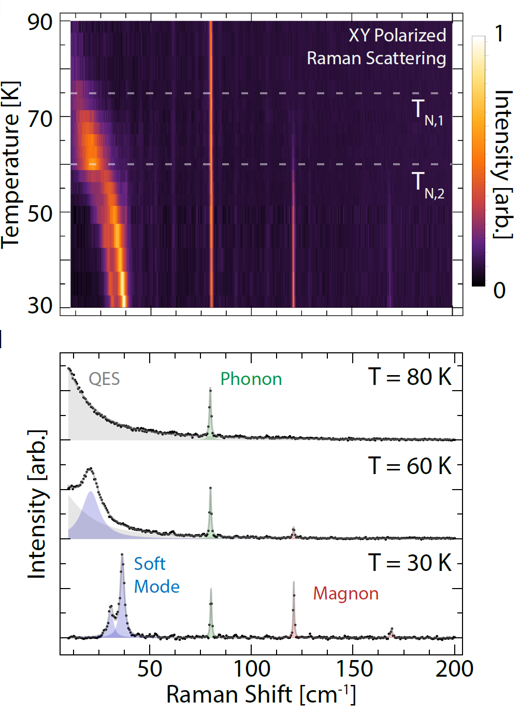 Photon scattering and spectroscopy techniques in the optical regime are among the most powerful probes of 2D materials. Such techniques include inelastic light (Raman) scattering, photoluminescence, differential reflection/absorption spectroscopy, circular/linear dichroism and magneto-optical Kerr-effect measurements. Together, these probes provide detailed information on the lattice (vibrational), magnetic, and electronic structure. Combined with in-house sample fabrication and in-situ tunability of temperature, magnetic/electric field, uniaxial strain and hydrostatic pressure, a wide variety of samples can be investigated within a broad range of their respective phase diagrams. In our group, these techniques are used to investigate magnetism in novel magnetic van der Waals materials, including magnetic 2D heterostructures, as well as optical signatures of moiré physics in twisted heterobilayers.
Photon scattering and spectroscopy techniques in the optical regime are among the most powerful probes of 2D materials. Such techniques include inelastic light (Raman) scattering, photoluminescence, differential reflection/absorption spectroscopy, circular/linear dichroism and magneto-optical Kerr-effect measurements. Together, these probes provide detailed information on the lattice (vibrational), magnetic, and electronic structure. Combined with in-house sample fabrication and in-situ tunability of temperature, magnetic/electric field, uniaxial strain and hydrostatic pressure, a wide variety of samples can be investigated within a broad range of their respective phase diagrams. In our group, these techniques are used to investigate magnetism in novel magnetic van der Waals materials, including magnetic 2D heterostructures, as well as optical signatures of moiré physics in twisted heterobilayers.
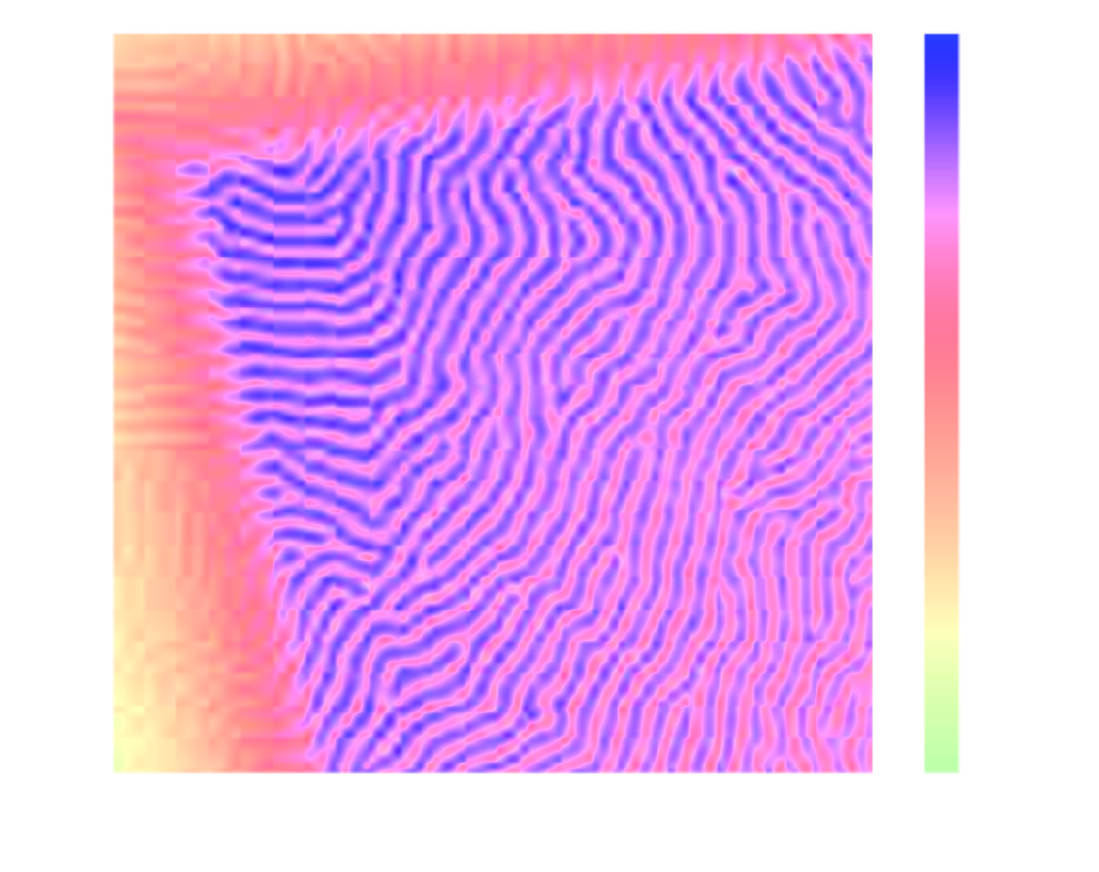 A unifying theme in the study of correlated electronic materials is the importance of mesoscale structure – patterns that exist on length scales between the atomic and the macroscopic. These patterns often arise from the competition between dissimilar ground states with nearly degenerate energies and can take many forms, such as nanoscale phase textures and long-wavelength modulations of charge and spin degrees of freedom. Due to fine balance of energy scales, sample heterogeneity often has major consequences for the functional properties of such materials, and imaging studies are required to properly understand how the macroscale behavior arises from the mesoscale patterns.
A unifying theme in the study of correlated electronic materials is the importance of mesoscale structure – patterns that exist on length scales between the atomic and the macroscopic. These patterns often arise from the competition between dissimilar ground states with nearly degenerate energies and can take many forms, such as nanoscale phase textures and long-wavelength modulations of charge and spin degrees of freedom. Due to fine balance of energy scales, sample heterogeneity often has major consequences for the functional properties of such materials, and imaging studies are required to properly understand how the macroscale behavior arises from the mesoscale patterns.
Soft x-ray microscopy would be an ideal way to study the spatial dependence of these materials, particularly in transition-metal based compounds, because the ability to perform experiments at selected atomic resonances makes it possible to highlight subtle electronic features. However, optics for soft x-rays are poor quality and very lossy, making it challenging to perform imaging experiments. In addition, most of the soft x-ray scattering signal associated with electronic structure variations arises from phase contrast, rather than amplitude contrast. Traditional imaging methods are either completely blind to this signal, or are unable to produce quantitative images of the phase contrast signal. We have been researching ways to apply coherent lensless imaging methods, which circumvent the need for efficient lenses and produce quantitative phase contrast images, to resonant soft x-ray scattering experiments. Examples of our recent efforts include works in progress on recovering images of antiferromagnetic ordering in rare earth nickelates and van Der Waals antiferromagnets. In addition, we have been developing new methodologies, such as Randomized Probe Imaging, designed to enable dynamic studies using the same contrast mechanisms.
